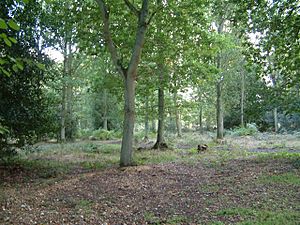Pamber Forest and Silchester Common facts for kids
| Site of Special Scientific Interest | |

Pamber Forest
|
|
| Area of Search | Hampshire |
|---|---|
| Interest | Biological |
| Area | 341.7 hectares (844 acres) |
| Notification | 1994 |
| Location map | Magic Map |
Pamber Forest and Silchester Common is a very special place in Tadley, Hampshire. It covers about 341.7-hectare (844-acre) of land. This area is known as a Site of Special Scientific Interest (SSSI).
An SSSI is a protected area. It means the land has important plants, animals, or rocks. These sites are protected by law to keep them safe for nature. Pamber Forest and Upper Inhams Copse are looked after by the Hampshire and Isle of Wight Wildlife Trust. Pamber Forest is also a Local Nature Reserve, which means it's important for local wildlife and people.
Contents
What Makes Pamber Forest Special?
Pamber Forest is a beautiful woodland. It has many old trees and plants. The forest is home to a mix of different habitats. These habitats help many kinds of wildlife to live and grow there.
A Home for Special Plants
The forest is famous for its hazel trees. These trees are often coppiced. This means they are cut back regularly. This helps new shoots grow from the base. It also creates a good habitat for other plants and animals.
Many tall oak trees grow above the hazel. These old trees provide homes for birds and insects. They also drop acorns, which are food for many forest creatures.
You can find some very old woodland plants here. These include orpine and wood horsetail. There are also beautiful lily of the valley flowers. In spring, you might see bright wild daffodils blooming. A rare plant called mountain fern also grows here.
The forest has over forty types of plants. Many of these are rare or uncommon in the UK. This shows how important Pamber Forest is for plant life.
Amazing Animals of the Forest
Because of its rich plant life, Pamber Forest is a great place for animals. Many different creatures live among the trees and plants.
You might spot various birds, like woodpeckers and owls. Small mammals, such as squirrels and badgers, also make their homes here. The forest's ponds and damp areas are good for frogs and newts. Many types of insects, including butterflies and beetles, thrive in this diverse habitat.
Protecting Our Nature
Pamber Forest and Silchester Common became an SSSI in 1994. This protection helps to keep the area healthy. It ensures that its special plants and animals can continue to live there.
Looking after places like Pamber Forest is very important. It helps us protect nature for the future. It also gives people a chance to enjoy and learn about wildlife.

